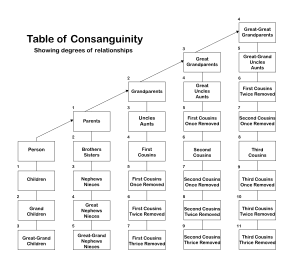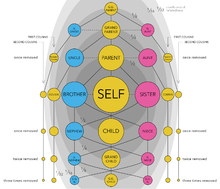Consanguinity

Consanguinity ("blood relation", from the Latin consanguinitas) is the property of being from the same kinship as another person. In that aspect, consanguinity is the quality of being descended from the same ancestor as another person.
The laws of many jurisdictions set out degrees of consanguinity in relation to prohibited sexual relations and marriage parties. Such rules are also used to determine heirs of an estate according to statutes that govern intestate succession, which vary from jurisdiction to jurisdiction. In some places and times, cousin marriage is approved and expected; in others, it is as taboo as incest.
For most of European history, cousin marriage was quite common. But in modern, Western Europe, it is generally illegal and practiced at a marginal rate.
The degree of relative consanguinity can be illustrated with a consanguinity table in which each level of lineal consanguinity (generation or meiosis) appears as a row, and individuals with a collaterally consanguineous relationship share the same row.[1] The Knot System is a numerical notation that defines consanguinity.[2]
Legal definitions

Modern secular law
Issues of consanguinity arise in several aspects of the law.
Laws prohibiting incest govern the degree of kinship within which marriage or sexual intercourse is permitted. These are almost universally prohibited within the second degree of consanguinity. Some jurisdictions forbid marriage between first cousins, while others do not. Marriage with aunts and uncles (avunculate marriage) is legal in several countries.
Consanguinity is also relevant to inheritance, particularly with regard to intestate succession. In general, the law favors inheritance by persons closely related to the deceased.
Some jurisdictions ban citizens from service on a jury on the basis of consanguinity with persons involved in the case.[3]
In many countries, laws prohibiting nepotism ban employment of, or certain kinds of contracts with, the near relations of public officers or employees.
Religious and traditional law
Christianity
 |
| Part of a series on the |
| Jurisprudence of Catholic canon law |
|---|
|
Trials and tribunals |
|
Canonical structures Particular churches
|
|
|
Procedural law Election of the Roman Pontiff
|
|
Academic degrees |
|
|
Under Roman civil law, which early canon law of the Catholic Church followed, couples were forbidden to marry if they were within four degrees of consanguinity.[4] In the ninth century the church raised the number of prohibited degrees to seven and changed the method by which they were calculated.[5] Eventually the nobility became too interrelated to marry as the pool of non-related prospective spouses became smaller. They had to either defy the church's position or look elsewhere for eligible marriage candidates.[5] In 1215 the Fourth Lateran Council made what they believed was a necessary change to canon law reducing the number of prohibited degrees of consanguinity from seven back to four.[6][7] The method of calculating prohibited degrees was changed also.[8] Instead of the former practice of counting up to the common ancestor then down to the proposed spouse, the new law computed consanguinity by counting back to the common ancestor.[8] In the Roman Catholic Church, unknowingly marrying a closely consanguineous blood relative was grounds for a declaration of nullity, but during the eleventh and twelfth centuries dispensations were granted with increasing frequency due to the thousands of persons encompassed in the prohibition at seven degrees and the hardships this posed for finding potential spouses.[9]
After 1215 the general rule was that while fourth cousins could marry without dispensation, generally the need for dispensations was greatly reduced.[9] In fourteenth century England, for example, papal dispensations for annulments due to consanguinity (and affinity) were relatively few.[10]
The connotations of degree of consanguinity varies by context (e.g., Canon law, Roman law, etc.). Most cultures define a degree of consanguinity within which sexual interrelationships are regarded as incestuous (the "prohibited degree of kinship").
Among the Christian Habesha highlanders of Ethiopia and Eritrea (the predominantly orthodox Christian Amhara and Tigray-Tigrinya), it is a tradition to be able to recount one's paternal ancestors at least seven generations away starting from early childhood, because "those with a common patrilineal ancestor less than seven generations away are considered 'brother and sister' and may not marry." The rule is less strict on the mother's side, where the limit is about four generations back, but still determined patrilinearly. This rule does not apply to Muslims or other ethnic groups.[11]
Islam
The Quran at 4:22-24 states. "Forbidden to you in marriage are: your mothers, your daughters, your sisters, your father's sisters, your mother's sisters, your brother's daughters, your sister's daughters."[12]
Hinduism
Ayurveda clearly states that marriage within the Gotra is a consanguineous marriage which can lead to many gestational and genetic problems in the fetus. So it has become a common practice in the Hindu households during pre-marriage discussions to ask the couples' Gotra. Couples of the same Gotra are advised not to marry. The advisers of this system say that this practice definitely helps in reducing the gestational problems and ensures a healthy progeny.
Genetic definitions
| Relationship | Average DNA shared % |
|---|---|
| Identical twin | 100% |
| Parent / Child | 50% |
| Full Sibling | 50% |
| Grandparent / Grandchild | 25% |
| Aunt / Uncle / Niece / Nephew | 25% |
| Half Sibling | 25% |
| First Cousin | 12.5% |
| Half-Aunt / Half-Uncle / Half Niece / Half-Nephew | 12.5% |
| Half-First Cousin | 6.25% |
| First cousin once removed | 6.25% |
| 2nd cousin | 3.13% |
| 2nd cousin once removed | 1.56% |


In genetic terms, consanguinity derives from the reduction in variation due to meiosis that occurs because of the smaller number of near ancestors. Since all humans share between 99.6% and 99.9% of their genome,[14] consanguinity only affects a very small part of the sequence. If two siblings have a child, then that child only has two rather than the normal four grandparents. In these circumstances the probability that the child inherits two copies of a harmful recessive gene (allele) rather than one (which would not have immediate effects) is much increased.
Conventionally, genetic consanguinity is expressed as defined by Wright[15] with the coefficient of relationship r, where r is defined as the fraction of homozygous due to the consanguinity under discussion. Thus, a parent and child pair has a value of r=0.5, siblings have a value of r=0.5, a parent's sibling has r=0.25, and first cousins have r=0.125. These are now often expressed in terms of a percentage of shared DNA.
As a working definition, unions contracted between persons biologically related as second cousins or closer (r ≥ 0.03125) are categorized as consanguineous. This arbitrary limit has been chosen because the genetic influence in marriages between couples related to a lesser degree would usually be expected to differ only slightly from that observed in the general population. Globally it is estimated that at least 8.5% of children have consanguineous parents.[16]
It is common to distinguish first-degree cousins, second-degree cousins, and often also third-degree cousins. Since comparatively few people can trace their full family tree for more than four generations, the identity of fourth-degree cousins often cannot be established. Also, at a genetic level, half-fourth cousins typically do not exhibit greater genetic similarity with one another than with any other individual from the same population.[17]
Double first cousins are descended from two pairs of siblings, and have the same genetic similarity as half-siblings.
Globally, the most common form of consanguineous union contracted is between first cousins, in which the spouses share 1/8 of their genes inherited from a common ancestor, and so their progeny are homozygous (or more correctly autozygous) at 1/16 of all loci (r = 0.0625).[18] Due to variation in geographical and ethnic background and the loci chosen to genotype there is some 2.4% variation expected. In practice the technical factors involved are the design of the SNP genotyping platform was used (e.g. which SNP array or sequencing method) and which software cut-offs were applied.[19]
Rates of occurrence
| Part of a series on the | ||||||||
| Anthropology of kinship | ||||||||
|---|---|---|---|---|---|---|---|---|
|
Basic concepts
|
||||||||
|
Terminology |
||||||||
|
Case studies
|
||||||||
|
Social anthropology Cultural anthropology | ||||||||
Europe
Historically, some European nobles cited a close degree of consanguinity when they required convenient grounds for divorce, especially in contexts where religious doctrine forbade the voluntary dissolution of an unhappy or childless marriage.[20] Conversely, the consanguinity law of succession requires the next monarch to be of the same blood of the previous one; allowing, for example, illegitimate children to inherit.
Muslims
Among modern Arabs the practice of marrying relatives is common. In the Arab world today between 40% and 50% of all marriages are consanguineous or between close family members, though these figures may vary among Arab nations.[21][22] Most Christian Arabs do not marry relatives as they do not believe in arranged marriages.
In Egypt, around 40% of the population marry a cousin. A 1992 survey in Jordan found that 32% were married to a first cousin; a further 17.3% were married to more distant relatives.[23] 67% of marriages in Saudi Arabia are between close relatives as are 54% of all marriages in Kuwait, whereas 18% of all Lebanese were between blood relatives.[24][25]
It is estimated that 55% of marriages between Pakistani Muslim immigrants in the United Kingdom are between first cousins,[26] where preferential patrilateral parallel cousin marriage (where a boy marries the daughter of his father's brother) is often favored.
The list of forbidden marriage partners, as read in the Qur'an, Surah 4:23, does not include first cousins.[27] Muhammad himself married his first cousin Zaynab bint Jahsh.[28]
Genetic disorders
The phenomenon of inbreeding increases the level of homozygotes for autosomal genetic disorders and generally leads to a decreased biological fitness of a population known as inbreeding depression, a major objective in clinical studies.[29] The offspring of consanguineous relationships are at greater risk of certain genetic disorders. Autosomal recessive disorders occur in individuals who are homozygous for a particular recessive gene mutation.[30] This means that they carry two copies (alleles) of the same gene.[30] Except in certain rare circumstances (new mutations or uniparental disomy) both parents of an individual with such a disorder will be carriers of the gene.[30] Such carriers are not affected and will not display any signs that they are carriers, and so may be unaware that they carry the mutated gene. As relatives share a proportion of their genes, it is much more likely that related parents will be carriers of an autosomal recessive gene, and therefore their children are at a higher risk of an autosomal recessive disorder.[31] The extent to which the risk increases depends on the degree of genetic relationship between the parents; so the risk is greater in mating relationships where the parents are close relatives, but for relationships between more distant relatives, such as second cousins, the risk is lower (although still greater than the general population).[32]
The low genetic heterozygosity associated with increased consanguinity in a population (identified by microsatellite markers) increases its susceptibility to infectious pathogens such as tuberculosis and hepatitis.[33]
See also
- Affinity (canon law) marriages prohibited due to marriage or sexual intercourse
- Milk kinship marriages prohibited due to sucklng or breastfeeding
- Affinity (law)
- Cognatic kinship
- Cousin marriage in the Middle East
- Genetic distance
- List of coupled cousins
- Heredity
- Genealogy
- Mendelian inheritance
- Nepotism
- Proximity of blood
References
- ↑ table of consanguinity
- ↑ Højrup, Knud, "The Knot System: A Numeric Notation of Relationship", National Genealogical Society Quarterly, Vol. 84, Numb. 2, p. 115, June 1996, ISSN 0027-934X.
- ↑ Ohio, for example, bars from juries in civil cases persons within the fourth degree of consanguinity to either party or their counsel (Ohio Revised Code §2313.17 (2012)); and persons within the fifth degree of consanguinity "to the person alleged to be injured or attempted to be injured by the offense charged, or to the person on whose complaint the prosecution was instituted, or to the defendant". Ohio Revised Code §2945.25 (1981).
- ↑ Constance Brittain Bouchard (24 November 2010). Those of My Blood: Creating Noble Families in Medieval Francia. University of Pennsylvania Press. p. 40. ISBN 0-8122-0140-X.
- 1 2 Bouchard, Constance B. (April 1981). "Consanguinity and Noble Marriages in the Tenth and Eleventh Centuries". Speculum. 56 (2): 268–287. doi:10.2307/2846935. JSTOR 2846935. PMID 11610836.
- ↑ "Fourth Lateran Council: Canon 50. Prohibition of marriage is now perpetually restricted to the fourth degree". 1215. Archived from the original on 2016-08-20.
- ↑ John W. Baldwin (28 May 1994). The Language of Sex: Five Voices from Northern France Around 1200. University of Chicago Press. p. 78. ISBN 978-0-226-03613-7.
- 1 2 Bouchard, Constance B. (April 1981). "Consanguinity and Noble Marriages in the Tenth and Eleventh Centuries". Speculum. 56 (2): 270. doi:10.2307/2846935. JSTOR 2846935. PMID 11610836.
- 1 2 James A. Brundage (15 February 2009). Law, Sex, and Christian Society in Medieval Europe. University of Chicago Press. p. 356. ISBN 978-0-226-07789-5.
- ↑ R. H. Helmholz (26 March 2007). Marriage Litigation in Medieval England. Cambridge University Press. p. 86. ISBN 978-0-521-03562-0.
- ↑ Wolbert Smidt, "Genealogy" in Siegbert Uhlig, ed., Encyclopaedia Aethiopica: D-Ha, (Wiesbaden: Harrassowitz Verlag, 2005), p. 743.
- ↑ "Surah An-Nisa [4:22-25]". Quran.com. Retrieved 16 June 2018.
- ↑ "Average percent DNA shared between relatives". 23andme. Retrieved 2018-05-06.
- ↑ Jorde, Lynn B; Wooding, Stephen P (2004). "Genetic variation, classification and 'race'". Nature Genetics. 36: S28–S33. doi:10.1038/ng1435. PMID 15508000. Retrieved 5 August 2016.
- ↑ Wright, Sewall (1922). "Coefficients of inbreeding and relationship". American Naturalist. 56 (645): 330–338. doi:10.1086/279872.
- ↑ Darr, Aamra. "Consanguineous Marriage and Inherited Disorders" (PDF). University of Bradford: City of Bradford. Retrieved 31 August 2016.
- ↑ Ask a Geneticist - Understanding Genetics: Human Health and the Genome - (by Dr. Erin Cline Davis, 23andMe Edited by Dr. DB Starr, Stanford University (10 October 2008)
- ↑ Bittles, A H (2001). "A Background Summary of Consanguineous Marriage" (PDF). Centre for Human Genetics Edith Cowan University, Perth, Australia. Retrieved 31 August 2016.
- ↑ Rehder; et al. (2013). "Documenting suspected consanguinity guidelines". Genet Med. 15 (2): 150–152. doi:10.1038/gim.2012.169.
- ↑ James A. Brundage, Law, Sex, and Christian Society in Medieval Europe (Chicago: University of Chicago Press, 1995), p. 193
- ↑ Centre for Arabic Genomic Research
- ↑ Bener A, Dafeeah EE, Samson N (2012). "Does consanguinity increase the risk of schizophrenia? Study based on primary health care centre visits". Ment Health Fam Med. 9 (4): 241–8. PMC 3721918. PMID 24294299.
- ↑ Consanguineous marriage: Keeping it in the family. Economist, 27 February 2016.
- ↑ The incidence of consanguinity was 54.3% among Kuwaiti natives and higher among Bedouins.
- ↑ Inbreeding and genetic disorder among Arab population.
- ↑ "Marriage between cousins increases risks to children". medicinechest.co.uk.
- ↑ "The Qur'an". Quran Surah An-Nisaa ( Verse 23 )
- ↑ "Islam's Women".
- ↑ Fareed M, Afzal M (2014). "Evidence of inbreeding depression on height, weight, and body mass index: a population-based child cohort study". Am. J. Hum. Biol. 26 (6): 784–95. doi:10.1002/ajhb.22599. PMID 25130378.
- 1 2 3 William J Marshall, Ph. D.; S K Bangert, Clinical biochemistry : metabolic and clinical aspects (Edinburgh; New York: Churchill Livingstone/Elsevier, 2008), p. 920
- ↑ Benjamin Pierce, Genetics: A Conceptual Approach (New York: W.H. Freeman, 2012), p. 138
- ↑ Kingston H M, "ABC of Clinical Genetics", 3rd Edition (London: BMJ Books, 2002), Page 7, ISBN 0-7279-1627-0
- ↑ Lyons EJ, Frodsham AJ, Zhang L, Hill AV, Amos W (2009). "Consanguinity and susceptibility to infectious diseases in humans". Biol Lett. 5 (4): 574–6. doi:10.1098/rsbl.2009.0133. PMC 2684220. PMID 19324620.
External links
| Look up consanguinity in Wiktionary, the free dictionary. |
- Province of Pennsylvania, statute prohibiting adultery and fornication (1705), with table of consanguinity, extracted from Smith's Laws
- Kalmes, Robert and Jean-Loup Huret. "Consanguinity." - Includes detailed information on the application of the coefficient of consanguinity
- Burtsell, Richard L. "Consanguinity (in Canon Law)." The Catholic Encyclopedia.
- Canon Law and Consanguinity
- Rehder C.W. et al.